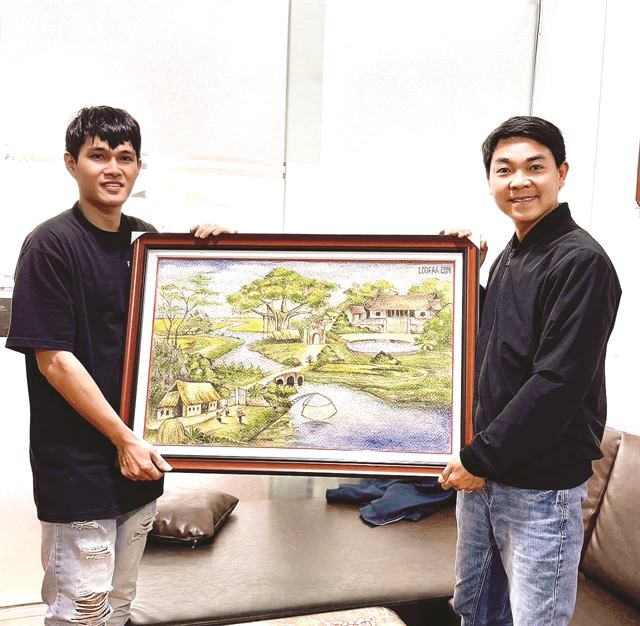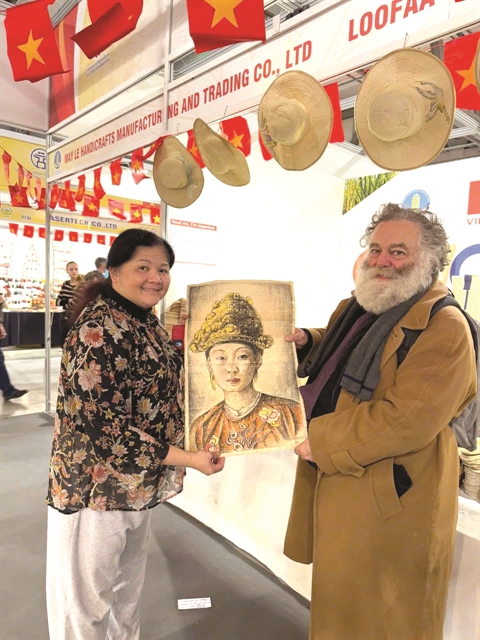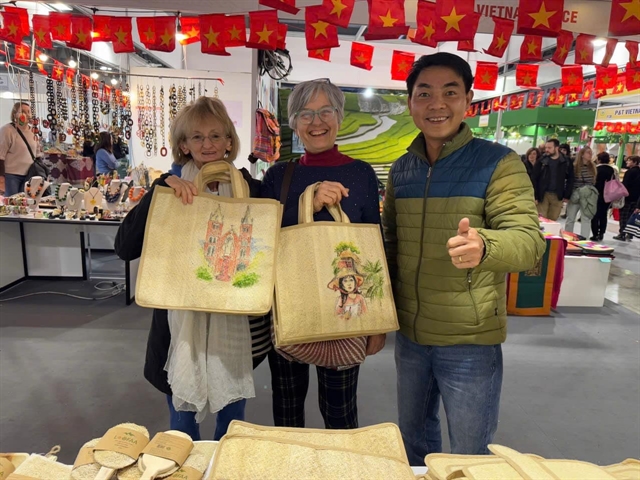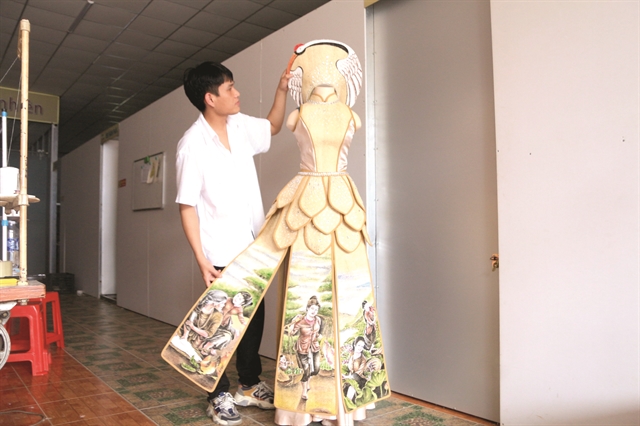The humble loofah, often seen as a simple sponge, has been transformed into a series of stunning works of art by Y Êli Buôn Krông from Buôn Ma Thuột City, in the Central Highlands province of Đắk Lắk.

AMAZING ART: Y Êli Buôn Krông (left) is pictured with one of his loofah paintings. Photo courtesy of Y Êli Buôn Krông
By Lương Hương
The humble loofah, often seen as a simple sponge, has been transformed into a series of stunning works of art by Y Êli Buôn Krông from Buôn Ma Thuột City, in the Central Highlands province of Đắk Lắk.
Blending functionality with aesthetics, Y Êli has turned the modest material into an artistic canvas that showcases Vietnamese culture to the wider world.
At 33, Y Êli’s creative journey has taken him far beyond his initial career as a tailor and his studies in design and painting. His turning point came when he joined Loofaa JSC, a business specialising in loofah products.
“Seeing my skills in drawing and design, the company’s director, Nguyễn Phú Tùng, encouraged me to decorate loofah bags and hats. Eventually, I began painting pictures on loofah canvases,” Y Êli said.
His first creation was a painting of the Eiffel Tower, inspired by a suggestion from a foreign tourist. This piece was later sold in France, marking the start of Y Êli’s new artistic path.
Painting on a loofah canvas, however, is no simple task. Its rough, coarse surface makes it difficult to achieve fine lines and vibrant colours. To overcome this, Y Êli worked with the company's sewing persons to sew dense chequered patterns onto the loofah mats. This innovative technique smoothed the surface, making it more suitable for painting on, while also enhancing its aesthetic appeal.

CLASSIC: Y Êli's loofah portrait of Vietnamese queen Nam Phương is exhibited and sold in Italy. — Photo courtesy of Y Êli Buôn Krông
Since then, Y Êli and his team at Loofaa have created hundreds of paintings inspired by various themes, most rooted in traditional Vietnamese culture.
“As Vietnamese people, we are proud of our homeland and national identity. We want to share the beauty of Việt Nam’s traditional culture with the world,” Y Êli told Việt Nam News.
His loofah paintings have been exhibited abroad, with prices ranging from VNĐ500,000 to over 3 million (US$22-130) per piece. They have been showcased at major trade fairs, including the Paris Fair in May, the Marseille Fair in September, and the Milan Fair in December 2024.
“The loofah artworks have been warmly received by consumers, who have started placing orders for these products,” Y Êli said.

BAGGED UP: Loofah bags with hand-painted pictures by Y Êli. — Photo courtesy of Y Êli Buôn Krông
Unique outfits
In addition to paintings, Y Êli has also channelled his creativity into designing one-of-a-kind outfits made of loofah.
His foray into fashion began when Loofaa proposed a loofah-themed fashion show in August 2024. The event offered a chance for the company’s workers to collaborate creatively, but also posed significant challenges. The material’s rough texture made it difficult to design wearable, visually striking garments.
After days of experimentation, Y Êli devised a solution: blending 20 per cent silk with 80 per cent loofah to craft an outfit inspired by traditional Vietnamese attire.
The resulting dress was inspired by the image of Mother Âu Cơ, a symbol of simplicity, resilience, and hard work in Vietnamese culture. Y Êli’s aim was to honour Việt Nam’s heritage while embedding meaningful values in his designs.
The dress featured three short layers resembling lotus petals, a familiar symbol in Vietnamese culture. Beneath these layers, five paintings depicted everyday moments of Vietnamese women: a mother selling street food, a grandmother caring for her grandchild, sisters picking lotus flowers, a sibling carrying a younger child, and a boy playing the flute while sitting on the back of a water buffalo.
“These images were carefully selected from thousands of paintings. I painted each one onto the flaps and applied a protective layer to preserve the colours,” Y Êli said.
To enhance the outfit’s appeal, he adorned it with hundreds of plastic gemstones, adding a dazzling sparkle. A traditional conical hat featuring a delicately painted stork completed the ensemble. The entire outfit took nearly a month to finish.
“Y Êli has consistently demonstrated relentless creativity, helping diversify our products and enhancing their appeal,” Loofaa director Tùng told the Danviet website.
“His craftsmanship has significantly increased the value of loofah, attracting attention not only from local customers but also from international markets,” Tùng added.

UNIQUE: The loofah dress was inspired by the image of Mother Âu Cơ—a symbol of simplicity, resilience, and hard work in Vietnamese culture. — Photo danviet.vn
Y Êli continues to innovate, currently developing unique men’s outfits for Loofaa’s next fashion show. He is also working on more environmentally friendly loofah products to meet consumer demand.
Looking to the future, the company plans to auction some of its loofah artworks and outfits, with proceeds dedicated to charity and social welfare.
For Y Êli, each creation is a testament to the rich cultural heritage of Việt Nam, a celebration of artistry, and a bold step forward for sustainable innovation. VNS